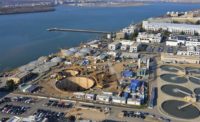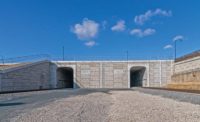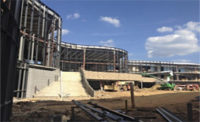Blue Plains Tunnel
District of Columbia
Best Project, Water/Environment
Owner DC Water
Lead Design/Structural Engineer/Engineer of Record CH2M
General Contractor Traylor, Skanska, Jay Dee Joint Venture (TSJD)
Hydraulics and Program Management Greeley and Hansen
Geotechnical Engineer McMillen Jacobs Associates
Construction Manager EPC Consultants
Electrical Leyden Electric
Slurry Wall Bencor Corp. of America
Rebar Bulldog Construction
Precast Tunnel Segments ConSeg JV/Bay State Precast
Instrumentation EMC2 Engineers
TBM Fabricator Herrenknecht Tunneling Systems
Environmental Controls Kroner Environmental Services Inc.
Waterproofing WISKO America Inc.
The Blue Plains Tunnel, a key element of DC Water’s Clean Rivers Project to bring the District of Columbia into compliance with the Clean Water Act, resulted in a series of firsts for the project team.
Built below and adjacent to the Potomac and Anacostia rivers, the combined sewer overflow tunnel aims to reduce overflows into the Anacostia by 98%. The $319-million project includes five deep shafts along its 4.5-mile length. They include a 132-ft-dia dewatering shaft and a 76-ft-dia screening shaft at the Blue Plains Advanced Wastewater Treatment Plant, the main access point for tunnel construction. The tunnel lining is composed of bolted precast steel fiber reinforced segments. A 400-ft-long, 1,300-ton tunnel-boring machine, dubbed “Lady Bird,” was custom-fabricated for the project.
To construct the 24,200-ft-long, 26-ft-dia tunnel in time to meet Clean Water Act-related deadlines, DC Water decided to turn to design-build delivery, a first for the authority. Choosing design-build created a steep learning curve for the project team.
Carlton Ray, DC Water director of DC Clean Rivers, says strong partnering was required from the project’s early stages to help head off potential challenges. Ray says DC Water instituted a “proprietary collaboration procurement process.” That included meeting with short-listed design-build teams in a confidential setting while technical and price proposals were being developed over a period of six months. The goal of the process was to enhance all parties’ understanding of project risks.
“When [teams] tendered their technical and cost proposals to us, we were confident they met all of the requirements,” Ray says. “Instead of just throwing the plans across the fence, we were very confident they understood the project. That reduced risk for us.”
During that period, the team proposed to co-locate the dewatering and screening shafts in a figure-eight pattern. That eliminated the need for a separate connector tunnel. It also expedited the tunnel boring machine’s assembly and its launch across the underground space. The 165-ft-deep shafts include composite diaphragm walls, inverted dome base slabs up to 25 ft thick and a waterproofing system. In 2013, Traylor Bros. Inc. and lead design firm CH2M won the International Tunneling Association’s Technical Innovation of the Year award for shaft design and construction for that facet of the project.
“The way that figure-eight shaft was designed and constructed could only be done under a design-build contract,” says Mark Johnson, CH2M regional tunnel practice manager for North America and project director for the tunnel’s design team. “Traditional procurement wouldn’t have allowed it because it combines state-of-the-art design practices with state-of-the-art monitoring and construction practices. If the design and construction parts were separated in any way, I don’t think, as designers, we could have made certain assumptions that the contractor would do things in a certain way.”
As work progressed, the team held regular partnering sessions and surveys between the owner and the contractor teams to provide constructive feedback.
DC Water was able to pursue and secure the first municipal century bond issued to a water/wastewater utility in the U.S., as well as the first “certified” green bond in the U.S. debt capital markets, according to the team.
Ray says bonding was made possible because the project was developed to have a 100-year design life, which was verified by an independent engineering firm. “Initially, the rating agencies were wary of it, but we talked them through the approach and they were confident in us,” he adds.
To mitigate risks associated with launching the tunnel boring machine, the team developed a cut-off wall system outside of the main launch shaft that provided protection against ground loss. In addition, intermediate shafts were partially backfilled with flow-fill concrete and flooded with water. That balanced external ground and groundwater pressures and reduced the risk of inundation.
Crews executed five separate shafts and tunneling with virtually no ground movements at any of the four shaft sites and along the 4.5-mile tunnel drive. Hundreds of monitoring points were installed along the tunnel route and checked continually for settlement issues during mining. There were no adverse impacts to adjacent structures or utilities, despite working close to pile-supported force mains, sensitive military installations and 100-year-old brick-arch sewers.
The tunnel boring machine, which got underway in July 2013 and completed its work in June 2015, achieved a best-day production of 150 ft, a best week of 631 ft and a best month of 2,081 ft.
Crews completed 1.6 million work-hours with no lost-time accidents.








Post a comment to this article
Report Abusive Comment